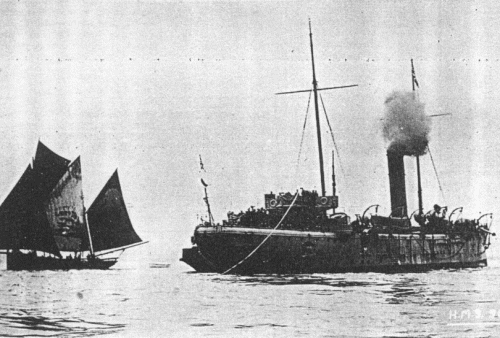
NAVYPEDIA
 Support the project with paypal
Support the project with paypal
Photo

Scout rearmed with 120mm guns
Ships
| Name | No | Yard No | Builder | Laid down | Launched | Comp | Fate |
|---|---|---|---|---|---|---|---|
| Scout | 223 | Thomson, Clydebank | 30.7.1885 | 30.7.1885 | 10.1886 | sold 7.1904 | |
| Fearless | 129 | Barrow Iron Sbdg Co | 22.9.1884 | 20.3.1886 | 7.1887 | sold 7.1905 |
Technical data
| Displacement normal, t | 1580 |
|---|---|
| Displacement full, t |
|
| Length, m | 67.1 pp 68.6 wl |
| Breadth, m | 10.4 |
| Draught, m | 4.42 |
| No of shafts | 2 |
| Machinery | sails + 2 2-cyl HC direct action, 4 boilers |
| Power, h. p. | natural draught: 2000 forced draught: 3200 |
| Max speed, kts | natural draught: 16 forced draught: 17 |
| Fuel, t | coal 450 |
| Endurance, nm(kts) | 6900(10) |
| Armour, mm | steel; deck: 10, gunshields: 25, TT: 25, CT: 76 |
| Armament | 4 x 1 - 127/25 BL Mk I/II/III/IV, 8 x 1 - 47/40 3pdr Hotchkiss Mk I, 2 x 1 - 11.4/78, 3 - 356 TT (2 bow (1 aw, 1 sm), 1 aft aw), 4 - 356 TC |
| Complement | 147 |
Standard scale images

Scout 1886

Fearless 1887
Graphics
Project history
Scout and Fearless were an attempt to produce small sea-going vessels of high speed and endurance capable of providing the fleet with defence against torpedo boat attacks and carrying out torpedo attacks on an enemy fleet. They had therefore to be larger than torpedo boats, which were not sufficiently seaworthy, but not so large as to be too expensive to build and operate in reasonable numbers. Unfortunately they proved to be poor seaboats and were too slow to operate effectively as fleet torpedo craft and they were therefore employed as small cruisers for commerce protection, scouting and independent duties. They were reclassified third class cruisers a few years after completion. They carried one 127mm BLR gun on each side of the poop and forecastle, abreast the fore- and mizzenmasts, and eight 47mm QFs on the upper deck, two each side amidships and one each side forward and aft. There was a fixed TT in the bow aw, one submerged, one TT submerged aft and two upper deck pairs of traversing TC, one under the forecastle and one under the poop, which could be moved across the ship to fire through ports on either side. They had two boiler rooms, with two boilers in each room, and a single engine room containing two engines fore and aft of each other. On trials Fearless made 17.27kts with 3302ihp and Scout 17.6kts with 3370ihp.
Ship protection
A 10mm steel deck, just below water level, provided splinter protection to the machinery compartments, and 25mm plating was fitted around the torpedo ports, but the main forms of protection were extensive watertight subdivision and the provision of wing coal bunkers abreast the boiler rooms and above the protective deck over the length of the machinery compartments.
Modernizations
1890s, both: - 4 x 1 - 127/25; + 4 x 1 - 120/40 QF Mk I/II/III/IV
Naval service
No significant events.
Many thanks to Wolfgang Stöhr for additional information on this page.
 HOME
HOME FIGHTING SHIPS OF THE WORLD
FIGHTING SHIPS OF THE WORLD UNITED KINGDOM
UNITED KINGDOM CRUISERS
CRUISERS SCOUT torpedo cruisers (2, 1886 - 1887)
SCOUT torpedo cruisers (2, 1886 - 1887)
